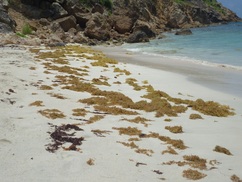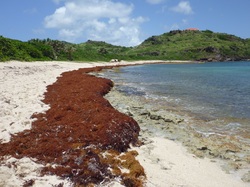Sargassum Summer
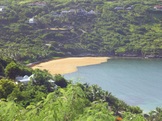
This piece was inspired by the arrival of tons of Sargasso seaweed in the Caribbean, that piled onto beaches and clogged inlets throughout the Caribbean islands from Guadeloupe to St Thomas. Bays and harbors in several island were un-navigable and had to be temporarily closed. In St Barths, Anse de Marigot (pictured here), Saline, St Jean, Gouverneur, Petite Anse, Grand and Petite Cul de Sac have large seaweed mounds. The seaweed is Sargassum and it comes from the Sargasso Sea, which is a floating ecosystem in the middle of the north Atlantic. It's a seaweed mat about the size of the USA. It is not unusual for sargassum weed to wash up on our Caribbean shores. But the sheer size and volume makes this an extraordinary and rare natural event.
Sargassum Summer
St Barthelemy, Caribbean August 2011
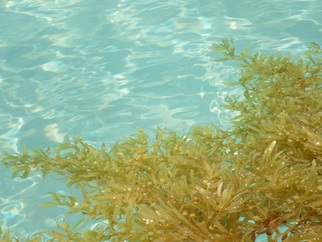
There are those who say that the lines on our palms tell the story of our life’s journey. They claim that by tracing the groove that runs from your index to little finger they can tell where you came from and where you are intended to go. Lines, it appears, are very important to our stories.
In late July, the idea of messages coded in lines was forefront in my mind on the flight across the waters dividing St Martin from St Barths. Looking down I could see golden brown lines stretched across the blue palm of the ocean. Like the hand of a time-aged woman, these dark furrows came in all sorts of patterns. There were long ones, short ones, deep ones and narrow ones. They collectively signaled that something had happened and foretold of something to come, - an event that would shape the beaches and bays of the islands in the time ahead. These were lines of sargassum seaweed and they stretched as far as the eye could see.
Sargassum lines tell a story. Theirs is a tale of ocean currents, a vast movement of water across thousands of miles and over millions of years. They tell of currents that created and guard a mysterious drifting ecosystem. And how the flow has ferried countless sea creatures from one continent to another, and governed their lives from the moment of spawning, through metamorphosis to death.
This Summer was Sargassum summer in the Caribbean. As July drew to a close the floating weed tumbled ashore along the chain of islands from Guadeloupe in the south to St Thomas in the north.
In late July, the idea of messages coded in lines was forefront in my mind on the flight across the waters dividing St Martin from St Barths. Looking down I could see golden brown lines stretched across the blue palm of the ocean. Like the hand of a time-aged woman, these dark furrows came in all sorts of patterns. There were long ones, short ones, deep ones and narrow ones. They collectively signaled that something had happened and foretold of something to come, - an event that would shape the beaches and bays of the islands in the time ahead. These were lines of sargassum seaweed and they stretched as far as the eye could see.
Sargassum lines tell a story. Theirs is a tale of ocean currents, a vast movement of water across thousands of miles and over millions of years. They tell of currents that created and guard a mysterious drifting ecosystem. And how the flow has ferried countless sea creatures from one continent to another, and governed their lives from the moment of spawning, through metamorphosis to death.
This Summer was Sargassum summer in the Caribbean. As July drew to a close the floating weed tumbled ashore along the chain of islands from Guadeloupe in the south to St Thomas in the north.
August
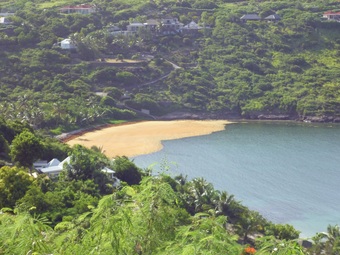
August, and sargassum has invaded St Barths like a mob of garish tourists flocking onto the beaches. Anse de Marigot (pictured here) looks like it’s been carpeted in a Bedouin rug. On the corners of Saline and Petite Cul de Sac you have to take a running jump over the weed to reach the water. Failure to clear the slippery hurdle means a humiliating slither on your rear-end. On morning beach walks, I meet the hotel sand-boys who, armed with rakes shovels and small buckets, march daily to battle the piles of weed that have built up overnight. But with such puny weapons they are soon overwhelmed. By next morning the weed is back, and these modern day Sisyphus are sent down to the beaches to start the cleanup all over again.
The seaweed invasion is unrelenting. Each wave washes another mat of golden weed ashore. Governments and businesses must respond. On the narrow St Barthian roads, trucks that used to transport construction materials now carry cargoes of rotting weed. If we can’t keep up with the incoming invasion, will we all be up to our eyeballs in decaying smelly weed? The odor soon attracts small winged creatures that like to feed and reproduce in it. But not us humans, sex and the smell of rotting seaweed is not something that comes instantly to mind even to the most nerdy of scientists.
The seaweed invasion is unrelenting. Each wave washes another mat of golden weed ashore. Governments and businesses must respond. On the narrow St Barthian roads, trucks that used to transport construction materials now carry cargoes of rotting weed. If we can’t keep up with the incoming invasion, will we all be up to our eyeballs in decaying smelly weed? The odor soon attracts small winged creatures that like to feed and reproduce in it. But not us humans, sex and the smell of rotting seaweed is not something that comes instantly to mind even to the most nerdy of scientists.
Questions
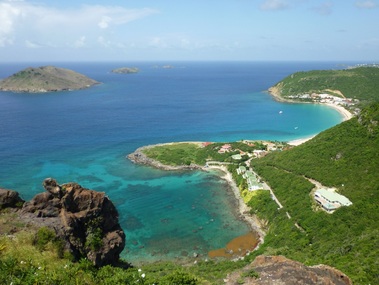
What is this weed? Why is it invading?
This is Sargassum seaweed, and it comes from the Sargasso Sea.
(image Petite Anse, St Barths August 2011)
In the middle of the Atlantic Ocean floats a 2,000,000 mi.² mat of seaweed. This is the Sargasso Sea, an ecosystem adrift. One that stretches from the Azores to the edges of the West Indies from around 20 to 35 degrees North latitude and 30 to 70 degrees longitude making it roughly similar in size to the United States. Unlike a rainforest with its roots to the ground, sargassum is anchored to nothing. Instead it is held in place by strong currents that press along its borders; on the west and north is the Gulf Stream, on the east the Canary current, and along the south, flows the North Equatorial current. These currents create an oasis of calm in a turbulent ocean, like a male tango dancer whose arms protect an intimate space for his partner to twirl with him on an over-crowded milonga in Buenos Aires.
Christopher Columbus who sailed into this mass of becalming seaweed is credited with its naming. As he drifted no doubt impatiently, and perhaps wishing he had a glass of wine to ease the boredom, he named the sea “Sargaco” after grapes. This is because the air bladders on the seaweed that keep it afloat reminded him of little grapes. Had he been a marine biologist he might have spent hours teasing the weed apart to discover the unusual creatures living among its fronds. Thus, Sargaco became the Sargasso Sea, and the weed Sargassum. The Sargasso Sea is a true ecosystem, and a habitat and temporary sanctuary for thousands of sea creatures.
At this time of year, many Caribbean turtles are emerging from their eggs. The hatchling scramble down the beach. Once in the water they swim quickly and instinctively for the Sargasso Sea. There, hidden among the weed they are safe from predators, and can feast on jellyfish, snails, crabs and shrimp that abound in this habitat. During their most vulnerable juvenile years, seven species of endangered turtles take refuge in sargassum.
The American and European eel leave their respective rivers and travel thousands of miles to spawn in the Sargasso Sea. In a mystery yet to be revealed, the elvers (young) of these creatures have eluded scientists and several expeditions to the Sargasso have failed to find them in any abundance. Should you be lucky enough to find any elvers in the weed that has washed ashore alert the scientific community because this will be an important discovery.
An elegant recycling system helps to generate and maintain the nutritional energy of the Sargasso Sea. The weed provides a home to animals. The animals that hide and feed among the weed produce waste products that provide nutrients for the weed, which then grows and reproduces and provides more habitat for more animals.
To commercial and sport fishermen, a patch of sargassum is usually a welcome sign. They know that the tiny fish and invertebrates that hide among the fronds attract bigger fish to eat them. These bigger fish can attract even bigger ones, which in turn attract even larger predators, humans.
This is Sargassum seaweed, and it comes from the Sargasso Sea.
(image Petite Anse, St Barths August 2011)
In the middle of the Atlantic Ocean floats a 2,000,000 mi.² mat of seaweed. This is the Sargasso Sea, an ecosystem adrift. One that stretches from the Azores to the edges of the West Indies from around 20 to 35 degrees North latitude and 30 to 70 degrees longitude making it roughly similar in size to the United States. Unlike a rainforest with its roots to the ground, sargassum is anchored to nothing. Instead it is held in place by strong currents that press along its borders; on the west and north is the Gulf Stream, on the east the Canary current, and along the south, flows the North Equatorial current. These currents create an oasis of calm in a turbulent ocean, like a male tango dancer whose arms protect an intimate space for his partner to twirl with him on an over-crowded milonga in Buenos Aires.
Christopher Columbus who sailed into this mass of becalming seaweed is credited with its naming. As he drifted no doubt impatiently, and perhaps wishing he had a glass of wine to ease the boredom, he named the sea “Sargaco” after grapes. This is because the air bladders on the seaweed that keep it afloat reminded him of little grapes. Had he been a marine biologist he might have spent hours teasing the weed apart to discover the unusual creatures living among its fronds. Thus, Sargaco became the Sargasso Sea, and the weed Sargassum. The Sargasso Sea is a true ecosystem, and a habitat and temporary sanctuary for thousands of sea creatures.
At this time of year, many Caribbean turtles are emerging from their eggs. The hatchling scramble down the beach. Once in the water they swim quickly and instinctively for the Sargasso Sea. There, hidden among the weed they are safe from predators, and can feast on jellyfish, snails, crabs and shrimp that abound in this habitat. During their most vulnerable juvenile years, seven species of endangered turtles take refuge in sargassum.
The American and European eel leave their respective rivers and travel thousands of miles to spawn in the Sargasso Sea. In a mystery yet to be revealed, the elvers (young) of these creatures have eluded scientists and several expeditions to the Sargasso have failed to find them in any abundance. Should you be lucky enough to find any elvers in the weed that has washed ashore alert the scientific community because this will be an important discovery.
An elegant recycling system helps to generate and maintain the nutritional energy of the Sargasso Sea. The weed provides a home to animals. The animals that hide and feed among the weed produce waste products that provide nutrients for the weed, which then grows and reproduces and provides more habitat for more animals.
To commercial and sport fishermen, a patch of sargassum is usually a welcome sign. They know that the tiny fish and invertebrates that hide among the fronds attract bigger fish to eat them. These bigger fish can attract even bigger ones, which in turn attract even larger predators, humans.
|
(Images: Start of the Sargassum invasion July 2011 (left, top) Anse de Petite Cul de Sac, two weeks later August 2011 (left bottom) It is not unusual to see small pieces of sargassum float up on Caribbean beaches particularly in July or August. This year however is extraordinary. The current hypothesis is that in May or June the currents were unusually strong and due largely to several storms in the region. As the currents bumped into the edges of the Sargasso Sea, they broke off pieces of ecosystem- like grabbing a piece of pie as you walk past the dinning table. The currents carried the weed along with them, eventually sweeping it eastwards into the Caribbean islands where local currents have carried it ashore. The paths followed by the seaweed teach us scientists about patterns in the ocean and how water, nutrients, and creatures travel. Like the songlines of the Aboriginal communities of Australia and the songs of the canoe-faring tribes of the Pacific Northwest, these lines provide us with a map that is key to knowledge. Once the weed arrives on the beaches of the Caribbean, a different story unfolds. The tiny invertebrates that have been carried along in the fronds are tasty morsels for shorebirds and coastal creatures. Wading birds and small migrant songbirds feast in the piles of weed. Look for them on beaches like Saline, or Grand Cul de Sac and Gouverneur, as they peck through the piles in order to find the choicest meal. The ghost crabs that live in burrows on the beach have relocated their homes closer to the seaweed mounds. In the early mornings or evening when the beaches are most empty of people, you can see them scurrying into the weed to grab a four-course meal- after all it is St Barths and French food is excellent. This bonanza of nutrition delivered by the sea to the birds, crabs and other creatures turns out to be vitally important. A pulse of energy results in greater reproductive output, in other words more babies. And these baby-boom years have important consequences because they boost the population density. In leaner years, when food and reproduction might be limited, this extra boost can make a big difference to survival of population and species. Last Sunday afternoon, hearing the beach disco at the Guanahani Hotel pound out an unrelenting bass line to the cheering party-goers, reveling in the summer music, I was aware that there truly was a sex and rock and roll party in full swing. This one was in the seaweed and with birds and winged insects and the crabs at least. We humans will benefit from the nutrient influx provided by sargassum to the coast and oceans. The greater productivity cascades through the food web including into fisheries. And there are immediate uses; sargassum weed is a great source of nutrition for plants. And if collected and washed off, it provides excellent fertilizer for plants. The weed that is collected from beaches can be composted or applied directly to vegetation including fruits and vegetables plants. Deborah Brosnan [email protected] home site deborahbrosnan.com (c) Deborah Brosnan 2011 |

